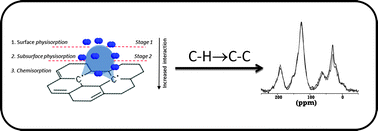Elucidating the role of stable carbon radicals in the low temperature oxidation of coals by coupled EPR–NMR spectroscopy – a method to characterize surfaces of porous carbon materials
Abstract
Recently, the nature of the carbon radicals stabilized in various coals was characterized using Electron Paramagnetic Resonance (EPR) spectroscopy. It was demonstrated that introducing diamagnetic gases, such as He, CO2, or N2, under STP conditions to the coal surface induces the appearance of a new type of carbon surface radical. This interesting phenomenon was not observed for all coal types, which suggests that the use of EPR measurements can provide information on functional groups that exist on the carbon surface. In the current study coupling Nuclear Magnetic Resonance (NMR) with gas flow in situ EPR measurements significantly enhances the ability to characterize the nature of these radicals and the surface functional groups of coal samples. It was observed that the oxidative reaction with aliphatic groups leads to the increase in stable carbon centered radicals. In addition, there are some species of carbon centered radicals that show reversible binding to O2. This phenomena, however, is dependent on the coal rank, sample porosity and the degree of the coal sample to undergo structural changes under the LTO process. These findings shed new light onto the complex heterogeneous low temperature oxidation reactions occurring at the coal surface.


 Please wait while we load your content...
Please wait while we load your content...